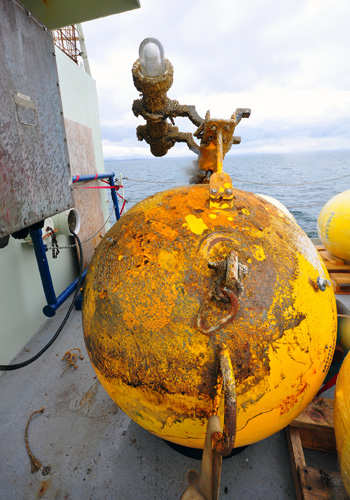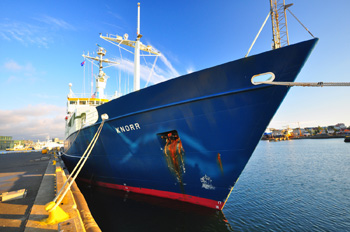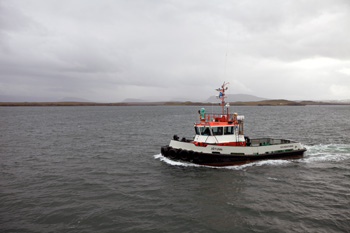August 21, 2011
As soon as I stepped off the gangway onto the main deck, my friend Pete, the chief engineer said, “Let me show you something.” “What?” “Don’t ask, just come.” He led me up a ladder to the 01 deck. “Remember this—?” “That’s not—“ “Yes. It is.” One of the central objectives of this cruise is to lay moorings across the Demark Strait between Iceland and Greenland. The foundation of oceanographic moorings is a stout wire with an anchor at the bottom and, near the surface, a top float 42 inches in diameter delivering about 2,000 pounds of buoyancy to keep the wire vertical. On it scientists can mount arrays of instruments to measure water temperature, salinity, and current velocity among other things. About ten spanking new mooring balls still in their protective plastic wrap were mounted on the deck, but one, separate from the rest, was badly battered and heavily encrusted with barnacles and marine growth. “I bet you never expected to see that again.” The weather on that 2008 cruise was spectacularly violent, one deep storm after another marching out of the west as closely packed as beads on a string. During a particularly savage 70-knot blow, a boarding sea ripped this mooring ball from the deck—the heavy lashings didn’t part; the wave tore away the metal mount welded to the side deck. The 2,000-pound ball had bounded aft along the starboard-side deck and stove in the steel bulwarks on the stern before it went over the side. We’re still telling the story of that storm. No one expected to see that expensive piece of gear ever again. But here it was. “How? What—?” “An Icelandic farmer found it on his land,” said Pete.
There was pleasing congruity in this both personally and, more important, scientifically, one circle closing, another beginning. In a couple of hours, we’ll be underway again heading back to those same waters where we were so harshly treated three years ago. But, then, that was in October. Now, in August, the storm track should be less active in our study area, but of course should and will are two different concepts when ocean and wind are involved, especially above the Arctic Circle. So all we can say for now is, we’ll see.
It’s 1015, August 22, and we’ve just cleared the inner breakwater in a fine drizzle, gunmetal gray clouds obscuring the mountaintops. Captain Kent Sheasley, Second Mate Jen Hickey, and helmsman Jose Andrate are on the bridge with the Reykjavik Harbor pilot. “Steer zero-five-zero,” said the pilot. “Zero-five-zero,” Jose repeated according to age-old protocol. “Keep the yellow buoy to port,” said the pilot. In practical terms, this process was unnecessary, since Knorr has been in and out of Reykjavik many times, but regulations require. The pilot boat approached, turned sharply, and took up station off our starboard side. Then, having passed the sea buoy, the pilot’s job was done. He and the captain exchanged official paperwork, shook hands, and the pilot left the bridge. “You can put her on the waypoint to the first station,” said Jen. “Three-three-zero.” “Three-three-zero.” “The pilot’s away,” reported a seaman on the radio from the main deck. Then Jen stepped out onto the bridge wing and struck the “pilot aboard” flag from the mast. Let that act signal the official start of our cruise. It was 1040. The rain stopped. A safety drill is scheduled for 1230, when we’re to report to our muster stations with life jackets and survival suits. The wind is very light, and she begins to roll with it ever so slightly. It feels good. We’re at sea. Last updated: December 27, 2011 | |||||||||||||||||
Copyright ©2007 Woods Hole Oceanographic Institution, All Rights Reserved, Privacy Policy. | |||||||||||||||||





